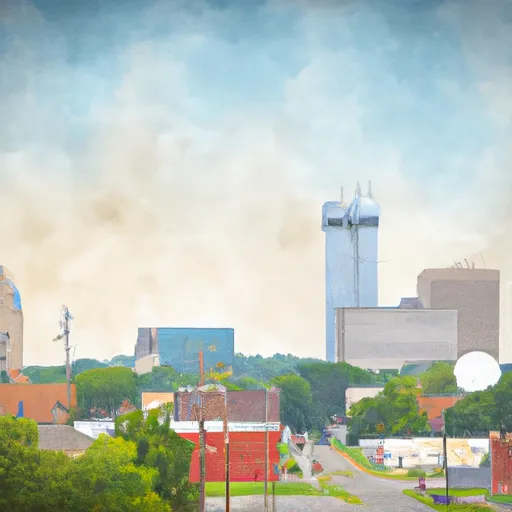-
 Snoflo Premium
Snoflo Premium
Get unlimited access to all our content
With no Ad interruptions! - Start Your Free Trial Login with existing account
Union-City
Eden Index
Climate
7.9
•
Recreation
2.2
•
Community
1.1
•
Safeguard
4.2/10

Union City, Indiana is a charming small town located in Randolph County. Situated in the Midwest region of the United States, the climate in Union City is classified as humid continental. Summers tend to be warm with temperatures ranging from 70 to 90 degrees Fahrenheit, while winters are cold with temperatures averaging between 20 to 40 degrees Fahrenheit. The town experiences moderate rainfall throughout the year.
Union City is intersected by the Mississinewa River, which provides opportunities for various hydrological activities. Fishing enthusiasts can enjoy angling for species such as bass, catfish, and sunfish. Additionally, the river offers picturesque scenery for kayaking and canoeing adventures.
Outdoor enthusiasts will find a range of recreational opportunities in Union City. The city boasts several parks and trails, including the Union City Community Park and the Bear Creek Trail. These areas offer opportunities for hiking, picnicking, and wildlife observation. Furthermore, golfers can enjoy a round of golf at the Winchester Golf Club, located just a short drive away.
Overall, Union City, Indiana provides residents and visitors with a pleasant climate, access to hydrological activities, and numerous outdoor recreation opportunities.
What is the Eden Index?
The Snoflo Eden Index serves as a comprehensive rating system for regions, evaluating their desirability through a holistic assessment of climate health, outdoor recreation opportunities, and natural disaster risk, acknowledging the profound impact of these factors on livability and well-being.
Climate Health Indicator (CHI): 7.9
Union-City receives approximately
997mm of rain per year,
with humidity levels near 83%
and air temperatures averaging around
11°C.
Union-City has a plant hardyness factor of
5, meaning
plants and agriculture in this region thrive during a short period during spring and early summer. Most
plants will die off during the colder winter months.
By considering the ideal temperature range, reliable water supplies, clean air, and stable seasonal rain or snowpacks, the Climate Health Indicator (CHI) underscores the significance of a healthy climate as the foundation for quality living.
A healthy climate is paramount for ensuring a high quality of life and livability in a region, fostering both physical well-being and environmental harmony. This can be characterized by ideal temperatures, reliable access to water supplies, clean air, and consistent seasonal rain or snowpacks.
Weather Forecast
Streamflow Conditions
Wabash
Area Rivers
Wabash
Snowpack Depths
Wabash
Reservoir Storage Capacity
Wabash
Groundwater Levels
Recreational Opportunity Index (ROI): 2.2
The Recreational Opportunity Index (ROI) recognizes the value of outdoor recreational options, such as parks, hiking trails, camping sites, and fishing spots, while acknowledging that climate plays a pivotal role in ensuring the comfort and consistency of these experiences.
Access to outdoor recreational opportunities, encompassing activities such as parks, hiking, camping, and fishing, is crucial for overall well-being, and the climate plays a pivotal role in enabling and enhancing these experiences, ensuring that individuals can engage in nature-based activities comfortably and consistently.
Camping Areas
| Campground | Campsites | Reservations | Toilets | Showers | Elevation |
|---|---|---|---|---|---|
| Miami Whitewater Forest | 50 | 543 ft | |||
| Bullock Pen Lake Ramp - DFWR | None | 774 ft | |||
| Quakertown State Rec Area - Brookville Lake | 450 | 762 ft | |||
| Big Bone Lick State Park | 60 | 496 ft | |||
| Governor Bebb Preserve | None | 729 ft | |||
| Boat Ramp - Elmer Davis Lake - DFWR | None | 735 ft | |||
| Brookville Lake | 465 | 694 ft | |||
| Mounds State Rec Area - Brookville Lake | 450 | 945 ft | |||
| Franklin County Park | None | 662 ft | |||
| Boltz Lake Ramp - DFWR | None | 842 ft |
Nearby Ski Areas
Catastrophe Safeguard Index (CSI):
The Catastrophe Safeguard Index (CSI) recognizes that natural disaster risk, encompassing floods, fires, hurricanes, and tornadoes, can drastically affect safety and the overall appeal of an area.
The level of natural disaster risk in a region significantly affects safety and the overall livability, with climate change amplifying these risks by potentially increasing the frequency and intensity of events like floods, fires, hurricanes, and tornadoes, thereby posing substantial challenges to community resilience and well-being.
Community Resilience Indicator (CRI): 1.1
The Community Resilience Indicator (CRI) recognizes that education, healthcare, and socioeconomics are crucial to the well-being of a region. The CRI acknowledges the profound impact of these elements on residents' overall quality of life. By evaluating educational resources, healthcare accessibility, and economic inclusivity, the index captures the essential aspects that contribute to a thriving community, fostering resident satisfaction, equity, and social cohesion.

